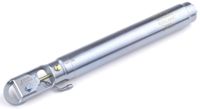Article
Epi-LASIK method, device helpful for patients with previous RK
The Epi-LASIK technique is a relatively new addition to the menu of refractive procedures from which patients can choose, and its results are beginning to be appreciated by surgeons.

Furthermore, the most recent experiences with the redesigned instrumentation with which Epi-LASIK is performed (Centurion SES microkeratome, Norwood Eye Care) indicate that the device is performing as expected and that patients are getting good visual results.
Warren Cross, MD, who works with the most recent generation of the Centurion SES microkeratome, has high praise for its use in the technique.
"Epi-LASIK is easily the procedure of choice for patients who have undergone a previous RK procedure because their epithelium is intact, the RK incisions are not opened, and there is no epithelial ingrowth," Dr. Cross explained. He has been performing Epi-LASIK in his Houston private practice since October 2003.
Epi-LASIK is not recommended for patients who have had a previous LASIK procedure, regardless of how much time has passed since the procedure was performed, according to Dr. Cross. He recounted the case of a patient who had undergone LASIK 9 years ago and needed an enhancement procedure.
"When the Epi-LASIK Separator came into contact with the previous LASIK incision, the Separator went straight across the corneas and lifted the flaps in both eyes of the patient," he said.
This case illustrates that the LASIK cut does not heal, Dr. Cross emphasized.
Initial findings Erik Mertens, MD, FBO, was part of a multicenter European study that analyzed the first results of Epi-LASIK using the Centurion SES microkeratome (distributed by CIBA Surgical at the time of the study) in 48 eyes. Dr. Mertens, who is medical director, Antwerp Eye Centre, Antwerp, Belgium, recounted his experience with 12 eyes of his patients.
Some of the pitfalls he encountered were inadequate suction, cessation of the microkeratome blade in mid-cut, and creation of free flaps.
"When treating the left eye of a patient, the aspiration tube can press on the orbital rim," Dr. Mertens said. "Even though we checked the IOP, which was adequate, there was inadequate suction in some cases."
Dr. Mertens also found that the microkeratome blade stopped oscillating in the middle of the cut while the instrument continues to move across the eye in steeper corneas starting from K readings of 45 D. In a case such as this, Dr. Mertens converts the case to PRK.
When he encountered a free flap, he carefully repositioned and aligned the flap. After applying a contact lens, the patient had a clear cornea. The uncorrected visual acuity was 20/40 1 day after the procedure.
"When applying a contact lens, I now use an Acuvue lens (Johnson & Johnson Vision Care Inc.) with a base curve of 9.1 or a pure vision contact lens and make sure there is no water under the contact lens," Dr. Mertens said. "I use two Merocel sponges: one to hold the contact lens in place and the other to get rid of excessive fluid under the contact lens. This minimizes patient discomfort after the procedure. I leave the contact lens in place now for 48 or 72 hours."
Dr. Mertens expressed enthusiasm with the procedure even before the instrument was redesigned to address the complications.
"With Epi-LASIK, the contact lens remains on the eye for 2 to 3 days, there is no epithelial loss, and the procedure is more comfortable for the patient than PRK, based on a survey of the patients," he said. "After 1 month, no haze developed in any cases."
Newsletter
Don’t miss out—get Ophthalmology Times updates on the latest clinical advancements and expert interviews, straight to your inbox.




